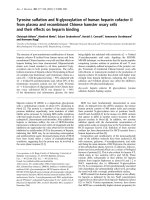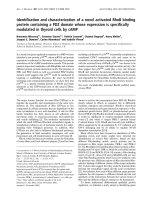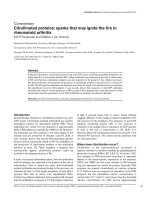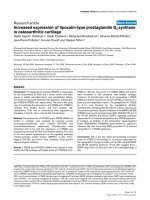Báo cáo y học: "Matrix metalloproteinases and their inhibitors: promising novel biomarkers in severe sepsi" ppt
Bạn đang xem bản rút gọn của tài liệu. Xem và tải ngay bản đầy đủ của tài liệu tại đây (47.23 KB, 3 trang )
Available online />Page 1 of 3
(page number not for citation purposes)
Abstract
The multicenter study conducted by Lorente and coworkers
published in the previous issue of Critical Care demonstrates that
matrix metalloproteinase (MMP)-9 and MMP-10 and their inhibitor
tissue inhibitor of matrix metalloproteinase-1 (TIMP-1) are
promising novel biomarkers to predict severity and outcome of
sepsis. In recent years MMPs have emerged as biomarkers in a
variety of diseases, such as sepsis, coronary artery disease,
cancer, heart failure, chronic lung disease and rheumatoid arthritis.
MMPs constitute a family of proteinases that are expressed during
developmental, physiological, and pathophysiological processes,
for example as a response to infection. Excessive inflammation
following infection may cause tissue damage, and MMPs are
implicated in causing this immunopathology. The activity of MMPs
is regulated by secretion of specific inhibitors (TIMPs). Studies
using MMP inhibitors and MMP knockout mice indicate that MMPs
play an essential role in infection and in the host response to
infection. The measurement of MMP-9 and MMP-10 and their
inhibitor TIMP-1 in the intensive care setting could be an attractive
noninvasive tool for determination of outcome of septic patients.
Introduction
In the previous issue of Critical Care, Lorente and coworkers
reported the results of a prospective cohort study evaluating
matrix metalloproteinases (MMPs) and tissue inhibitors of
metalloproteinases (TIMPs) as potential biomarkers for the
determination of sepsis severity and for the prediction of
mortality in septic patients [1]. The authors found that
nonsurviving septic patients presented with lower MMP-9
levels, higher TIMP-1 levels and a lower MMP-9/TIMP-1 ratio.
Moreover, they showed that TIMP-1 levels can predict the
clinical outcome of septic patients and could be useful for
risk stratification of patients with sepsis.
MMPs have been shown to be important in the pathogenesis
and development of inflammatory diseases and are intimately
involved in the regulation of the activities of cytokines and
cytokine receptors [2]. Pathophysiologically, a successful
eradication of infection by the host requires the influx of
effector cells into the infected tissue, killing of the pathogen,
resolution of inflammation and, finally, remodeling of the
extracellular matrix. Excessive inflammation following infection
may cause tissue damage, however, and MMPs are impli-
cated in causing this immunopathology [3].
Several mechanisms account for increased MMP and TIMP
levels in the setting of sepsis. First of all, human neutrophils
secrete gelatinase B (MMP-9) in vivo and in vitro in response
to endotoxin and proinflammatory mediators such as TNFα or
IL-8 [4]. Secondly, TIMP-1 can activate normal human granu-
locytes, protecting them from apoptosis and blocking their
transmigration during inflammation [5].
Elevated serum levels of MMPs have been described in some
studies in response to endotoxin and proinflammatory media-
tors [4], and MMPs can be considered as markers of
inflammation in various diseases [6,7]. Studies that investi-
gate MMPs and their inhibitors in septic diseases are rare
and have involved only limited numbers of patients. MMP-9
levels have been shown to be elevated in patients with severe
sepsis compared with healthy control individuals [8,9]. In a
small study of 20 patients with septic shock, Nakamura and
colleagues found elevated MMP-9 levels in nonsurvivors of
severe sepsis as compared with survivors and healthy
controls [10]. Unfortunately, Lorente and coworkers cannot
confirm these results in their multicenter study [1]; on the
contrary, these authors show lower MMP-9 and a reduced
MMP-9/TIMP-1 ratio in nonsurviving septic patients [1]. In
accordance with a previous study [9], the TIMP-1 values
were higher in septic patients. Moreover, TIMP-1 levels were
shown to have prognostic implications in severe septic
patients as has been described before [1,9]. Lorente and
Commentary
Matrix metalloproteinases and their inhibitors: promising novel
biomarkers in severe sepsis?
Ursula Hoffmann, Martina Brueckmann and Martin Borggrefe
1st Department of Medicine, Faculty of Medicine Mannheim, University of Heidelberg, Theodor-Kutzer-Ufer 1–3, D-68167 Mannheim, Germany
Corresponding author: Ursula Hoffmann,
Published: 1 December 2009 Critical Care 2009, 13:1006 (doi:10.1186/cc8156)
This article is online at />© 2009 BioMed Central Ltd
See related research by Lorente et al., />IL = interleukin; MMP = matrix metalloproteinase; TIMP = tissue inhibitor of matrix metalloproteinase; TNF = tumor necrosis factor.
Critical Care Vol 13 No 6 Hoffmann et al.
Page 2 of 3
(page number not for citation purposes)
coworkers define an elevated risk of death in septic patients
with a cut-off value >531 ng/ml for TIMP-1 according to their
receiver operating curve analysis [1]. This result is quite
different to another study in septic patients, which evaluated
a cut-off value >3,200 ng/ml for TIMP [9].
Importantly, Lorente and colleagues could show an
association of MMP-9, MMP-10 and TIMP-1 with the severity
of sepsis and a correlation of these parameters with markers
of inflammation on the time of diagnosis of sepsis [1], which
was not demonstrated in a previous study in septic patients [9].
A limitation of the study by Lorente and colleagues, however,
is the lack of serial measurements of MMPs and TIMPs over
several days, which could help to confirm the association
between these markers with the severity of sepsis as
assessed by the Sequential Organ Failure Assessment score
and Acute Physiology and Chronic Health Evaluation score.
Matrix metalloproteinases and tissue
inhibitors of metalloproteinases as
biomarkers in the intensive care unit
Recent data and cumulative analysis indicate that biomarkers
improve diagnosis of sepsis and may help to predict the
prognosis of septic patients. Biomedical scientists are
aggressively investigating biomarkers of disease and injury.
In the scene of sepsis biomarkers, C-reactive protein, IL-6
and procalcitonin are the most investigated markers in clinical
trials. In recent published studies, procalcitonin is of better
value for diagnosis and prognosis of sepsis when compared
with markers such as C-reactive protein or with proinflam-
matory cytokines such as IL-6 [11-13]. There are additional
new sepsis markers with so far limited clinical evidence, for
example triggering receptor on myeloid cells or N-terminal
pro-brain natriuretic peptide [14,15]. Unfortunately, bio-
markers rarely alter our clinical decision-making in severe
sepsis as they are often nonspecific, lack adequate sensitivity
and/or are difficult to measure and to interpret accurately.
Metalloproteinases and their inhibitors may represent a
promising new class of biomarkers for the prognosis of
severe sepsis patients. The development of specific inhibitors
of MMPs [16] or TIMPs as a new class of drugs for sepsis
therapy is challenging, and future clinical trials have to clarify
their role within the treatment regime of septic patients.
Conclusion
The use of biomarkers may improve early diagnosis and
therapy in critically ill patients, and may consecutively influ-
ence the morbidity and mortality of these patients.
The implementation of metalloproteinases and their inhibitors
as new biomarkers for the severity of sepsis and for mortality
in critically ill patients may provide promising decision
support for the intensivist to guide the allocation of hospital
resources. Additional larger studies are needed, however, to
determine the cellular origin and the relevance of these
enzymes in sepsis.
Competing interests
MBr is an employee of Boehringer Ingelheim GmbH,
Germany. The other authors declare that they have no
competing interests.
Acknowledgements
The present work was supported by a grant of the Faculty of Medicine
Mannheim, University of Heidelberg, Germany.
References
1. Lorente L, Martin MM, Labarta L, Diaz C, Solé-Violán J, Blanquer J,
Orbe J, Rodriguez JA, Jiménez A, Borreguero-Léon JM, Belmonte
F, Medina JC, LLiminana MC, Ferrer-Agüero JM, Ferreres J, Mora
ML, Lubillo S, Sánchez M, Barrios Y, Sierra A, Páramo JA: Matrix
metalloproteinase-9, -10, and tissue inhibitor of matrix metal-
loproteinases-1 blood levels as biomarkers of severity and
mortality in sepsis. Crit Care 2009, 13:R158.
2. Opdenakker G, Van den Steen PHE, Van Damme J: Gelatinase
B: a tuner and amplifier of immune functions. Trends Immunol
2001, 22:571-579.
3. Elkington PTG, O`Kane CM, Friedland JS: The paradox of matrix
metalloproteinases in infectious disease. Clin Exp Immunol
2005, 142:12-20.
4. Pugin J, Widmer MC, Kossodo S, Liang CM, Preas II HL, Suffre-
dini AF: Human neutrophils secrete gelatinase B in vitro and
in vivo in response to endotoxin and proinflammatory media-
tors. Am J Respir Cell Mol Biol 1999, 20:458-464.
5. Chromek M, Tullus K, Lundahl J, Brauner A: Tissue inhibitor of
metalloproteinase 1 activates normal human granulocytes,
protects them from apoptosis, and blocks their transmigra-
tion during inflammation. Infect Immun 2004, 72:82-88.
6. Kotyza J, Pesek M, Puzman P, Havel D: Progelatinase B/matrix
metalloproteinase-9 proenzyme as a marker of pleural inflam-
mation. Exp Lung Res 2004, 30:297-309.
7. Ferroni P, Basili S, Martini F, Cardarello CM, Ceci F, Di Franco M,
Bertazzoni G, Gazzaniga PP, Alessandri C: Serum metallopro-
teinase 9 levels in patients with coronary artery disease: a
novel marker for inflammation. J Investig Med 2003, 51:295-
300.
8. Yassen KA, Galley HF, Webster NR: Matrix metalloproteinase-9
concentrations in critically ill patients. Anaesthesia 2001,
56:729-732.
9. Hoffmann U, Bertsch T, Dvortsak E, Liebetrau C, Lang S, Liebe V,
Huhle G, Borggrefe M, Brueckmann M: Matrix-metallopro-
teinases and their inhibitors are elevated in severe sepsis:
prognostic value of TIMP-1 in severe sepsis. Scand J Infect
Dis 2006, 38:867-872.
10. Nakamura T, Ebihara I, Shimada N, Shoji H, Koide H: Modulation
of plasma metalloproteinase-9 concentrations and peripheral
blood monocyte mRNA levels in patients with septic shock:
effect of fiber-immobilized polymyxin B treatment. Am J Med
Sci 1998, 316:355-360.
11. Harbarth S, Holeckova K, Froidevaux C, Pittet D, Ricou B, Grau
GE, Vadas L, Pugin J: Diagnostic value of procalcitonin, inter-
leukin-6 and interleukin-8 in critically ill patients admitted with
suspected sepsis. Am J Respir Crit Care Med 2001, 164:396-
402.
12. Castelli GP, Prognani C, Meisner M, Stuani A, Bellomi D, Sgarbi
L: Procalcitonin and C-reactive protein during systemic
inflammatory response syndrome, sepsis and organ dysfunc-
tion. Crit Care 2004, 8:R234-R240.
13. Clech C, Ferriere F, Karoubi P, Fosse JP, Cupa M, Hoang P,
Cohen Y: Diagnostic and prognostic value of procalcitonin in
patients with septic shock. Crit Care Med 2004, 32:
1166-1169.
14. Roch A, Allardet-Servent J, Michelet P, Oddoze C, Forel JM,
Barrau K, Loundou A, Perrin G, Auffray JP, Portugal H, Papazian
L: NH
2
terminal pro-brain natriuretic peptide plasma level as
an early marker of prognosis and cardiac dysfunction in
septic shock patients. Crit Care Med 2005, 33:1001-1007.
15. Gibot S, Pe LR, Bollaert PE, Kolopp-Sarda MN, Béné MC, Faure
GC, Lévy B: Surface triggering receptor expressed on myeloid
cells 1 expression patterns in septic shock. Intensive Care
Med 2005, 31:594-597.
16. Lalu MM, Gao CQ, Schulz R: Matrix metalloproteinase
inhibitors attenuate endotoxemia induced cardiac dysfunc-
tion: a potential role for MMP-9. Mol Cell Biochem 2003,
251:61-66.
Available online />Page 3 of 3
(page number not for citation purposes)









